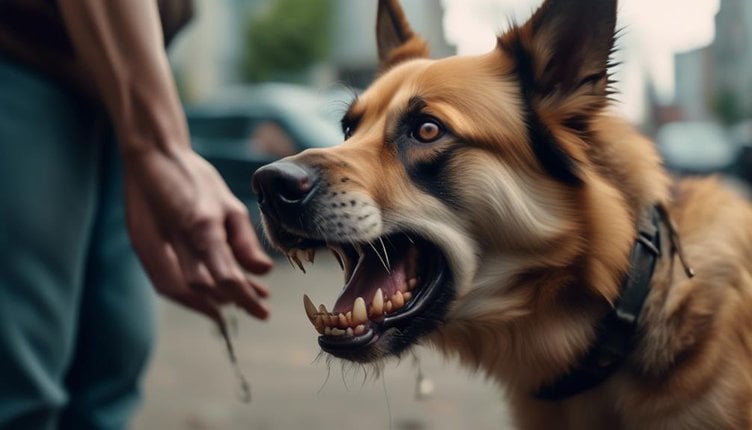Hey there, dog owners! Picture this: the sun slowly dipping below the horizon, casting a warm glow on a peaceful suburban neighborhood. But wait, what's that? A low growl pierces the tranquility, sending shivers down your spine. It's the bone-chilling sound of a rabid dog, striking fear into even the bravest hearts.
Now, let's talk about something serious – rabies. It's a viral disease that attacks the nervous system, posing a deadly threat to both dogs and humans. And guess what? I've got all the essential information you need to know to keep your furry friend (and yourself) safe.
First things first, let's dive into the symptoms. Rabies doesn't mess around, so it's crucial to be aware of the signs. Look out for behavioral changes like aggression, disorientation, and excessive drooling. If your dog starts acting out of the ordinary, it's time to take notice.
But hey, prevention is the name of the game. So, how can you stop this nasty virus from spreading? Simple. Make sure your dog is up to date on their rabies vaccinations. It's a no-brainer, really. Plus, keeping your dog away from wildlife and unknown animals can significantly reduce the risk of exposure.
Now, I know you're probably wondering about your own safety. If your dog comes into contact with a rabid animal or gets bitten, don't hesitate – seek medical attention immediately. It's better to be safe than sorry, my friends.
So, there you have it – the vital details you need to know about rabies. Stay vigilant, keep those vaccinations up to date, and remember, knowledge is power when it comes to protecting your furry companion.
Now go out there, armed with this information, and keep your neighborhood safe from the horrors of rabies.
Understanding Rabies: An Overview
Rabies, a deadly viral disease, affects the central nervous system of mammals, including dogs, and poses a significant threat to public health. Understanding the transmission and prevention of rabies is crucial in serving the needs of the community.
Rabies is primarily transmitted through the bite or scratch of an infected animal, with dogs being the most common source of human infection worldwide. The virus is present in the saliva of infected animals and can enter the body through broken skin or mucous membranes. It then travels along nerves to the brain, leading to severe neurological symptoms and, ultimately, death.
Preventing rabies requires a multi-faceted approach. Vaccination is the cornerstone of rabies prevention in dogs, as it helps to create immunity against the virus. Vaccinating dogs not only protects them from infection but also prevents the transmission of the virus to humans.
In addition to vaccination, other preventive measures include avoiding contact with stray animals or wildlife, especially those showing signs of aggression or unusual behavior. Educating communities about the importance of responsible pet ownership, such as keeping dogs on a leash and reporting animal bites, is also crucial in preventing the spread of rabies.
Recognizing Rabies Symptoms in Dogs
Recognizing rabies symptoms in dogs is crucial for early intervention and prevention of transmission. Visible behavioral changes, such as aggression, restlessness, and increased vocalization, are often observed in infected dogs.
In addition, neurological abnormalities like seizures, paralysis, and difficulty swallowing may also be apparent.
Timely recognition of these symptoms can help protect both the affected dog and the surrounding community from the risks associated with rabies.
Visible Behavioral Changes
One can observe significant changes in the behavior of dogs infected with rabies. These visible behavioral changes are important signs and symptoms that can help owners recognize the presence of the disease.
Here are some key behaviors to watch out for:
- Aggression: Infected dogs may display sudden and unprovoked aggression towards people or other animals.
- Restlessness: Dogs infected with rabies often exhibit increased anxiety and restlessness.
- Disorientation: They may appear confused and disoriented, frequently getting lost even in familiar surroundings.
- Excessive salivation: Rabid dogs may have difficulty swallowing, resulting in excessive drooling and foaming at the mouth.
- Lethargy: Some infected dogs may also display extreme lethargy and weakness.
It is crucial for dog owners to be aware of these changes and seek immediate veterinary attention if any of these symptoms are observed. Early detection and treatment are essential in preventing the spread of rabies and ensuring the well-being of both the infected dog and those around it.
Neurological Abnormalities
Neurological abnormalities are prominent indicators of rabies infection in dogs, revealing the impact of the disease on the dog's central nervous system. These abnormalities can manifest in various ways, providing important clues for early detection and diagnosis. Recognizing these symptoms is crucial for timely treatment and prevention of further spread of the disease.
To help you identify these neurological abnormalities, here is a handy table outlining common symptoms associated with rabies in dogs:
| Neurological Abnormalities | Symptoms |
|---|---|
| Aggression | Unprovoked biting or snapping |
| Paralysis | Weakness or inability to move |
| Seizures | Uncontrolled muscle twitching |
| Disorientation | Confusion or aimless wandering |
If you notice any of these symptoms in your dog, it is essential to consult a veterinarian immediately. Diagnostic tests, such as brain tissue analysis or saliva testing, can confirm the presence of rabies. Unfortunately, there is no cure for rabies in dogs, and treatment options are limited to supportive care to alleviate symptoms and keep the dog comfortable. Remember, prevention through vaccination is the best defense against this deadly disease.
How Rabies Spreads: Transmission Routes

Rabies is transmitted through the saliva of infected animals, primarily through bites or scratches. The virus is present in the saliva of an infected animal and can enter the body through broken skin or mucous membranes.
Understanding the transmission routes of rabies is crucial in preventing its spread and protecting both humans and animals. Here are the key transmission routes:
- Saliva contact: Rabies can be transmitted when infected saliva comes into contact with mucous membranes or open wounds. This can occur through activities such as petting or handling an infected animal.
- Bites: The most common mode of transmission is through bites from infected animals. The virus can be present in the saliva of an infected animal and can be introduced into the body through the puncture wound caused by the bite.
- Scratches: While less common, rabies transmission can also occur through scratches from infected animals. If the virus is present in the saliva or on the claws of an infected animal, it can enter the body through the broken skin caused by the scratch.
- Organ transplantation: In rare cases, rabies transmission has occurred through organ transplantation from a donor who was infected with the virus. This emphasizes the importance of rigorous screening and testing procedures for organ donors.
- Inhalation of aerosolized virus: Although extremely rare, there have been a few cases of rabies transmission through inhalation of aerosolized rabies virus in laboratory settings. This mode of transmission isn't relevant to the general public but is worth noting for scientific purposes.
The Importance of Rabies Vaccination
Vaccination against rabies is a crucial measure in preventing the spread of the virus and protecting both human and animal populations. The benefits of early vaccination cannot be overstated. Rabies is a deadly disease that affects the nervous system of mammals, including dogs. Once symptoms appear, it is almost always fatal. However, with timely vaccination, the chances of survival are significantly increased.
Table: Importance of Rabies Vaccination
| Point | Explanation |
|---|---|
| Protects the dog | Vaccinating dogs against rabies ensures their protection from the virus, preventing the development of the disease. |
| Prevents transmission to humans | Vaccinated dogs are less likely to contract rabies, reducing the risk of transmission to humans through bites or scratches. |
| Legal requirement | Many countries and states have laws mandating rabies vaccination for dogs. Compliance with these laws is crucial. |
| Public health significance | Rabies is a zoonotic disease, meaning it can be transmitted from animals to humans. Vaccination helps protect public health. |
| Veterinarians play a vital role | Veterinarians play a key role in promoting vaccination by educating pet owners, administering vaccines, and ensuring compliance. |
The role of veterinarians in promoting vaccination cannot be understated. They play a vital role in educating pet owners about the importance of early vaccination. Veterinarians administer the vaccines and ensure compliance with legal requirements. Their expertise and guidance are crucial in protecting both the individual dog and the wider community from the threat of rabies. By working together, pet owners and veterinarians can effectively prevent the spread of rabies and ensure the health and safety of both humans and animals.
Steps to Prevent Rabies in Dogs

With a focus on preventing the spread of rabies in dogs, it's essential to implement specific steps to safeguard both human and animal populations. By following these preventive measures, dog owners can significantly reduce the risk of rabies transmission:
- Vaccination: Ensuring that dogs receive the appropriate rabies vaccinations is crucial in preventing the transmission of the virus. Vaccination requirements may vary depending on the region, so it's essential to consult with a veterinarian to stay up to date with local regulations.
- Leash and supervise: Keeping dogs on a leash and under supervision when outdoors can prevent encounters with potentially rabid animals. This reduces the chances of bites and direct exposure to the virus.
- Avoid wildlife interaction: Discouraging dogs from interacting with wildlife, such as raccoons, bats, and foxes, is crucial. These animals can carry and transmit the rabies virus to dogs through bites or scratches.
- Secure trash and food sources: Properly securing garbage cans and storing pet food indoors can help deter wildlife from entering the premises and potentially transmitting rabies to dogs.
- Promptly report suspicious behavior: If a dog displays abnormal behavior or shows signs of aggression, excessive salivation, or difficulty swallowing, it's crucial to report it to local animal control authorities immediately. This can help identify potential rabid animals and prevent further transmission.
Dealing With a Rabid Dog: What to Do
Taking immediate action is crucial when faced with a rabid dog to ensure the safety of both humans and other animals. Dealing with a rabid dog requires a prompt and coordinated emergency response. The first step is to protect oneself and others from immediate danger. It's essential to maintain a safe distance and avoid any physical contact with the dog. If possible, try to confine the dog in a secure area, such as a room or a yard, to prevent it from causing harm to others.
Next, contact the local animal control authorities or the nearest animal shelter to report the incident. Provide them with accurate information about the dog's location and behavior. This will enable them to take appropriate action and ensure the safety of the community.
While waiting for professional help to arrive, it's important to avoid approaching or attempting to handle the rabid dog. Rabies is a highly contagious disease that can be transmitted through bites or scratches. It's crucial to protect oneself and others by staying away from the infected animal.
In the event of a rabid dog attacking a person or another animal, it's vital to seek immediate medical attention. Rabies is a life-threatening disease that requires prompt medical intervention. The person or animal should be taken to the nearest healthcare facility for assessment and treatment.
Rabies in Humans: Potential Risks and Precautions

After addressing the immediate dangers of dealing with a rabid dog, it's important to understand the potential risks and precautions associated with rabies in humans.
Rabies is a viral disease that can be transmitted from animals to humans through the bite or scratch of an infected animal. Here are some key points to consider regarding rabies transmission and prevention:
- Vaccination: The most effective way to prevent rabies in humans is through vaccination. It's crucial for individuals at high risk, such as veterinarians, animal control workers, and travelers to rabies-endemic areas, to receive the rabies vaccine.
- Animal contact: Avoiding contact with wild animals, especially bats, raccoons, foxes, and skunks, is essential. Teaching children to stay away from unfamiliar animals and to report any bites or scratches is also crucial.
- Post-exposure prophylaxis: In case of potential exposure to rabies, immediate medical attention is vital. Post-exposure prophylaxis, which includes wound cleaning, rabies vaccination, and sometimes, rabies immune globulin, can prevent the virus from spreading.
- Awareness: Being aware of the signs and symptoms of rabies in animals can help individuals identify potentially infected animals and take appropriate precautions.
- Education: Educating the public about rabies prevention and the importance of responsible pet ownership can help reduce the risk of transmission and ensure the safety of both humans and animals.
Frequently Asked Questions
Can Dogs Get Rabies From Eating Infected Animals?
Yes, dogs can contract rabies from eating infected animals. This poses a serious health risk as rabies is transmitted through the saliva of infected animals. It is important to take necessary precautions to protect both dogs and humans from this deadly disease.
What Should I Do if My Dog Has Been Bitten by a Rabid Animal?
If a dog is bitten by a rabid animal, immediate action is crucial. Dealing with a rabid animal bite requires steps such as seeking immediate veterinary care. Prompt treatment is of utmost importance.
Are There Any Home Remedies or Natural Treatments for Rabies in Dogs?
Contrary to popular belief, there are no home remedies or natural treatments for rabies in dogs. Rabies is a serious viral infection that requires immediate medical attention and vaccination.
Is It Safe to Handle a Dead Rabid Dog?
Handling a dead rabid dog poses a significant risk of rabies transmission. It is essential to avoid direct contact with the animal and to notify local animal control authorities for proper disposal and further guidance.
Can My Dog Still Get Rabies Even if It Has Been Vaccinated?
Yes, dogs can still get rabies even if they have been vaccinated. While the rabies vaccine is highly effective, it is not 100% foolproof. Additionally, rabies can also be transmitted through scratches from infected animals.





